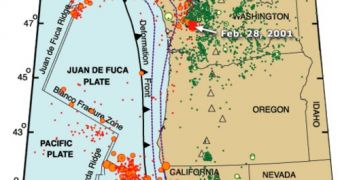Geologists and seismologists have been drawing attention for quite some time now that, just off the coast of the Pacific Northwest, there is an area of intense geological activity that has largely remained under-researched. At that location, they reveal, the North American plate subdues the Juan de Fuca tectonic plate, which dives beneath, and into the planet's mantle. This is not done smoothly, experts say, and tension is constantly being accumulated along the fault lines. As a result, the possibility of a devastating earthquake being produced here is fairly high, Nature News reports.
The entire region is known as the Cascadia zone. If its seismic history is any indicator, then the area is not to be taken lightly, experts warn. Around 1700, a major earthquake was produced along its fault lines. The magnitude of the tremor was estimated to be of about 9, and a very large tsunami was created. The shock waves traveled across the Pacific Ocean, and produced major devastation in Japan, where the tsunami landed. Since, the faults have been relatively still, which is not to say that they are inactive.
On the contrary, the more still tectonic plates are over extended periods of time, the more likely they are to produce a major tremor once they unleash their accumulated energy. This energy, geologists reveal, is produced by friction accumulating at the contact zone between two plates. The one sinking under the other is being constantly pushed from behind. When it hits a block, it jams, but the pressure from the back does not ease. Eventually, the two forces go out of balance, and the plate being subdued is violently pushed onwards, and in the mantle. This is what triggers earthquakes.
“People haven't appreciated the level of hazard there for both an earthquake and a tsunami. This study will over the long term provide a fundamental understanding of the Earth's structure and the hazard,” geophysicist John Orcutt, from the La Jolla, California-based Scripps Institution of Oceanography, says. He is also a member of a new scientific project, which aims to wire up the Cascadia region with sensors that could help seismologists become more aware of the risk level these fault lines entail. The science project costs about $10 million, and experts in charge of implementing it say that it is now on a fast track to be fully set up by early next year.
“This will be the most comprehensive study of a subduction zone conducted anywhere to date,” the Cascadia initiative Project Manager, Richard Carlson, says of the investigation. He is based at the US National Science Foundation (NSF) in Arlington, Virginia.

 14 DAY TRIAL //
14 DAY TRIAL //